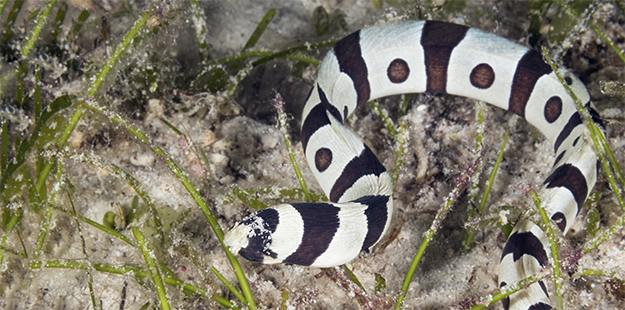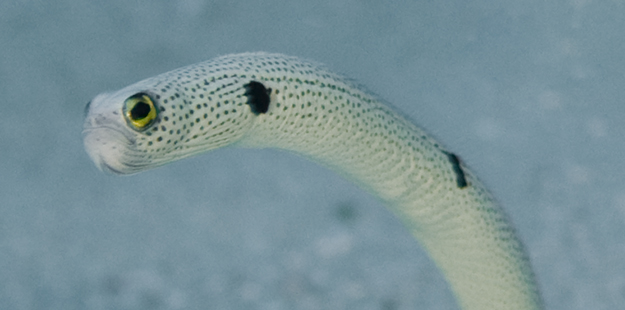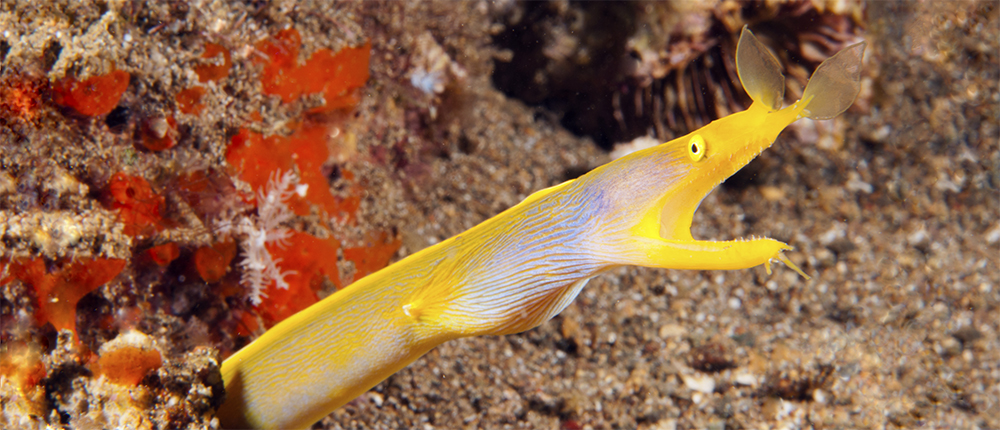Eel Appeal

Follow a harlequin snake eel as it propels through the sea grass on the House Reef, and you may soon see it back its way into the bottom, tail first. Photo by Walt Stearns
Snake eels are well-adapted to their subterranean lifestyle. They lack protruding fins that would make burrowing more difficult, and their elongated nostrils are positioned downward, allowing the eel to bury itself completely, leaving just the tip of the nose exposed to sense food or get a whiff of passing danger. These eels have evolved rigid, pointed tails that work like a digging spade, allowing the animal to burrow its way backwards into the sand. Snake eels will occasionally emerge from their burrows to slither across the bottom, propelling themselves with full-body wave-like undulations. If you are lucky enough to happen across a snake eel on the move, follow at a respectful distance and you may soon see it disappearing tail first as it backs its way into the bottom.
Garden varieties
These members of the conger eel family are true homebodies. After spending their first weeks of life drifting with the currents, young garden eels will soon settle on a patch of sand and dig an underground shelter. Once ensconced, they rarely if ever leave their burrows. From the shelter of their underground lairs, they will extend about a third of their bodies upward into the water column, where they spend their days daintily picking away at drifting morsels of plankton carried by the currents. These eels typically live in colonies, and when they are out and feeding en masse, their undulations can resemble a meadow of tall grass blowing gently in the breeze.

: Unlike their distant cousin, the moray, garden eels have relatively poor sense of smell, but excellent eyesight. Photo by Walt Stearns
If you manage a stealthy approach to a group of garden eels, and don’t cause the entire colony to retreat into their burrows, you may notice that these eels have big eyes set near the tip of their blunt heads, and small nostrils set close to their upper lips. These features hint at the eel’s sensory priorities, as they have a relatively poor sense of smell, and excellent eyesight. Their keen vision not only helps them lock on to passing morsels of food, it also allows them to spot approaching threats in time to retreat into the safety of their borrows. Garden eels never share a burrow, which can make it a bit tough when it’s time to make some baby eels.

Sneak up close enough and you might notice the garden eel’s large eyes and small nostrils set close to their upper lips, which helps them lock on to passing snacks. Photo by Wakatobi Resort
The solution for these solitary dwellers is to move their individual burrows closer together during mating season. So if you happen across a colony of garden eels on a Wakatobi reef that seems unusually tight packed, it might be that time of year.
Ready to do some eel spotting of your own? We’re here to help you plan your trip. Complete a quick trip inquiry at wakatobi.com.
Visit us on Facebook.


